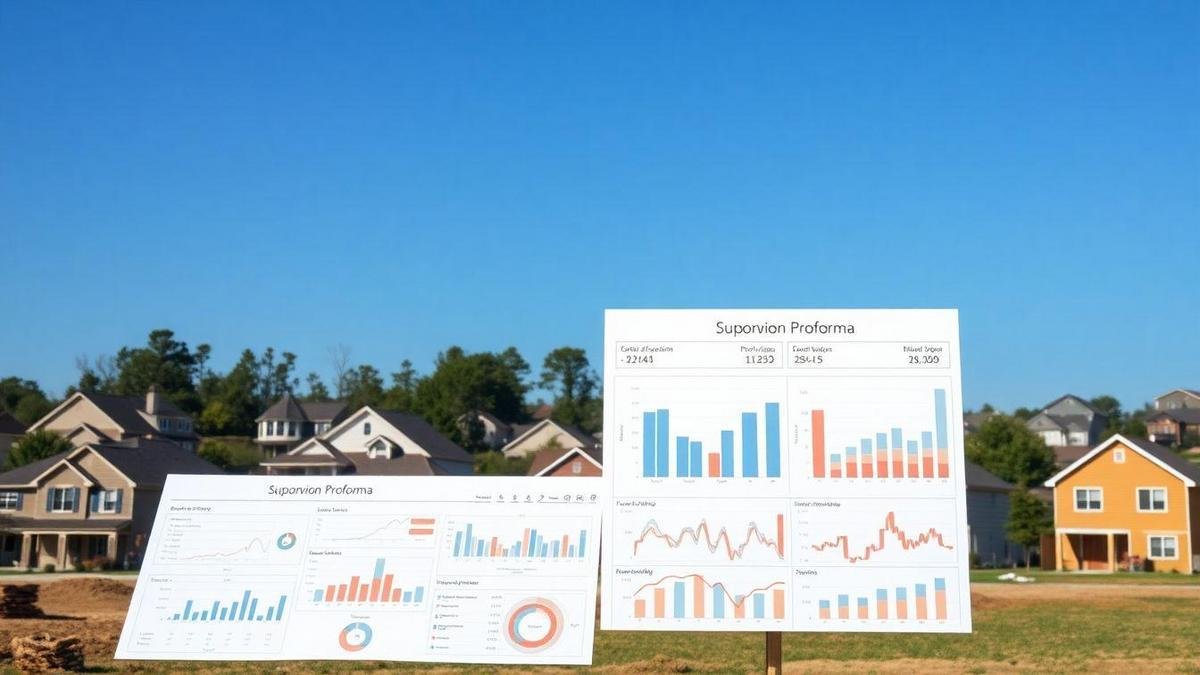The subdivision proforma template in US is a vital tool for developers and investors in real estate. This article will explore its key components, the significance of accurate financial projections, and how to create a comprehensive financial projection tool. Readers will also learn about the benefits of using a real estate development template, ways to streamline the development process, and enhance decision-making. With insights on conducting a project feasibility analysis, budgeting essentials, and effective cost estimation, this guide aims to improve financial accuracy and support better investment choices.
- A subdivision proforma helps in budgeting for land development.
- It estimates costs and potential profits.
- Easy to create with clear sections.
- Use templates for quick setup.
- Review it regularly for accuracy.

Understanding the Subdivision Proforma Template in US
Key Components of a Subdivision Proforma Template
A subdivision proforma template in US serves as a vital tool for investors. It outlines the financial aspects of a land development project. Here are the key components that make up this template:
- Project Overview: This section provides a brief description of the development, including location and size.
- Cost Estimates: Detailed breakdown of expenses, including land acquisition, construction, and permits.
- Revenue Projections: Expected income from selling or leasing the developed properties.
- Financing Details: Information on loans, interest rates, and other funding sources.
- Profit Analysis: A summary of expected profits after all costs are accounted for.
Importance of Accurate Financial Projections
Accurate financial projections are crucial in land development. They help investors gauge the potential success of a project. When these projections are reliable, they can:
- Guide Decision-Making: Investors can make informed choices based on realistic expectations.
- Attract Financing: Lenders are more likely to support projects with solid financial forecasts.
- Mitigate Risks: By understanding potential pitfalls, investors can prepare for challenges ahead.
How to Create a Comprehensive Financial Projection Tool
Creating a comprehensive financial projection tool involves several steps. Here’s a simple guide to help investors get started:
- Gather Data: Collect historical data on similar projects to inform your estimates.
- Define Assumptions: Clearly state the assumptions behind your projections, such as market trends and interest rates.
- Use Software: Consider using spreadsheet software to organize your data and calculations.
- Review Regularly: Financial projections should be updated regularly to reflect changes in the market or project scope.
| Step | Description |
|---|---|
| Gather Data | Collect relevant historical data |
| Define Assumptions | Clearly state the assumptions for projections |
| Use Software | Utilize spreadsheets for organization |
| Review Regularly | Update projections based on market changes |

Benefits of Using a Real Estate Development Template
Streamlining the Development Process
Using a real estate development template can significantly simplify the development process. Templates provide a clear structure, making it easier for developers to outline their projects. This clarity helps in organizing thoughts and plans, reducing the time spent on project setup. For instance, when a developer uses a subdivision proforma template in US, they can quickly fill in essential details without starting from scratch. This efficiency is crucial for meeting deadlines and keeping projects on track.
Enhancing Decision-Making for Investors
Investors benefit greatly from using templates as they provide valuable insights into the project’s potential. A well-crafted template allows investors to compare different projects side by side. This comparison aids in making informed decisions. For example, an investor can look at projected costs, expected returns, and timelines all in one place. This not only saves time but also helps in identifying the best opportunities in the market.
The Role of Templates in Reducing Errors
Templates play a vital role in minimizing mistakes. By following a standardized format, developers and investors can avoid overlooking critical details. A template acts as a checklist, ensuring that all necessary components are considered. This systematic approach can prevent costly errors that might arise from miscalculations or missing information. For instance, a subdivision proforma template in US includes sections for zoning regulations, financial projections, and market analysis, which are crucial for a successful project.
| Template Feature | Benefit |
|---|---|
| Clear Structure | Simplifies project setup |
| Comparative Analysis | Aids in informed decision-making |
| Error Reduction | Minimizes costly mistakes |
| Comprehensive Information | Covers all critical project aspects |

Conducting a Project Feasibility Analysis
Assessing Market Demand and Trends
When investors look at land development, the first step is to assess market demand. Understanding what people want is crucial. This means looking at the types of properties that are in high demand, such as residential homes, commercial spaces, or mixed-use developments.
To do this effectively, he can:
- Analyze Local Demographics: Who lives in the area? What are their ages, incomes, and family sizes?
- Study Recent Sales Data: What properties sold quickly? What prices are buyers willing to pay?
- Monitor Economic Indicators: Is the local economy growing? Are jobs being created?
By gathering this information, he can spot trends and make informed decisions about the types of developments that will attract buyers.
Evaluating Financial Viability
Next, it’s important to evaluate the financial viability of the project. This means looking at the costs involved and the potential profits. Investors need to know if the project will be worth their time and money.
Key points to consider include:
- Construction Costs: What will it cost to build?
- Projected Sales Prices: How much can he sell the properties for?
- Financing Options: What are the best ways to fund the project?
A clear understanding of these factors will help determine if the project is financially sound.
Steps to Perform a Thorough Feasibility Study
To perform a thorough feasibility study, he should follow these steps:
- Define the Project Scope: What is the goal? Is it a residential subdivision or a commercial complex?
- Conduct Market Research: Use surveys and interviews to gather data.
- Analyze Financials: Create a subdivision proforma template in US to outline costs and expected returns.
- Assess Risks: Identify potential challenges and how to overcome them.
- Compile Findings: Put everything together in a report that outlines the feasibility of the project.
By following these steps, he can make a well-informed decision about whether to proceed with the development.

Land Development Budgeting Essentials
Creating a Detailed Budget Plan
A detailed budget plan is crucial for successful land development. It serves as a roadmap, guiding investors through the financial landscape. To craft this plan, one must start by identifying all potential expenses. This includes:
- Land acquisition costs
- Permitting and legal fees
- Construction costs
- Marketing expenses
- Contingency funds
Each category should be broken down into specific line items. For example, under construction costs, include labor, materials, and equipment rental. This level of detail helps investors see where their money is going and aids in making informed decisions.
Identifying Potential Cost Overruns
Cost overruns can derail a project quickly. It is essential to identify areas where expenses may exceed the budget. Some common culprits include:
- Unforeseen site conditions
- Changes in design
- Delays due to weather
To combat these issues, investors should conduct thorough site assessments and stay flexible with their plans. Having a contingency fund can also cushion the blow of unexpected costs.
Best Practices for Effective Budget Management
Effective budget management is like steering a ship through stormy seas. Here are some best practices to keep finances on course:
- Regular Monitoring: Review the budget frequently to catch discrepancies early.
- Clear Communication: Maintain open lines of communication with all stakeholders to avoid misunderstandings.
- Use a Subdivision Proforma Template in US: This tool can help streamline budgeting and provide a clear overview of financial projections.
| Best Practices | Description |
|---|---|
| Regular Monitoring | Keep an eye on expenses and adjust as needed. |
| Clear Communication | Share updates and changes with all involved. |
| Subdivision Proforma | Utilize templates for better financial tracking. |
By following these guidelines, investors can navigate the complexities of land development budgeting with confidence.

Utilizing Financial Projection Tools
Types of Financial Tools for Developers
When developers embark on a project, they often rely on financial projection tools to make informed decisions. These tools can vary widely, but here are some common types:
- Spreadsheet Software: Programs like Excel are popular for creating custom financial models. They allow developers to manipulate data easily and visualize projections.
- Real Estate Investment Software: These specialized tools provide features tailored for real estate analysis, such as cash flow forecasting and return on investment calculations.
- Project Management Tools: Software like Trello or Asana can help track project timelines and budgets, integrating financial data with overall project management.
- Subdivision Proforma Template in US: This specific template assists developers in understanding the financial feasibility of subdivision projects, highlighting costs, revenues, and potential profits.
How to Choose the Right Tool for Your Project
Selecting the right financial tool is crucial for any development project. Here are some factors to consider:
- Project Size: For smaller projects, a simple spreadsheet might suffice. Larger developments may require more sophisticated software.
- Complexity of Financials: If the project involves intricate financial scenarios, specialized software could provide the necessary depth.
- User-Friendliness: The tool should be easy to use. A complicated tool can lead to mistakes and confusion.
- Integration Capabilities: Ensure the tool can work with other systems already in use, allowing for seamless data flow.
Integrating Tools into the Development Workflow
Integrating financial tools into the development workflow is essential for streamlined operations. Here’s how developers can do this effectively:
- Regular Updates: Keep financial data current by updating the tools regularly. This helps in making timely decisions.
- Training Team Members: Ensure that everyone involved is trained on how to use the tools effectively. This fosters collaboration and minimizes errors.
- Feedback Loop: Establish a system for team members to provide feedback on the tools. This can lead to improvements and better functionality.
| Tool Type | Best For | Key Features |
|---|---|---|
| Spreadsheet Software | Small to medium projects | Custom models, data manipulation |
| Real Estate Investment Software | Detailed analysis | Cash flow forecasting, ROI calculations |
| Project Management Tools | Tracking timelines and budgets | Task management, budget tracking |
| Subdivision Proforma Template | Subdivision projects | Cost estimation, revenue projections, profit analysis |

Estimating Subdivision Costs Accurately
Factors Influencing Subdivision Costs
When considering subdivision costs, several key factors come into play. These elements can significantly impact the overall budget for a project. Here are some of the main influences:
- Land Acquisition Costs: The price of purchasing the land is often the largest expense.
- Development Regulations: Local zoning laws and building codes can dictate what can be built and how much it will cost to comply.
- Site Preparation: This includes clearing, grading, and any necessary environmental assessments.
- Infrastructure Needs: Costs related to roads, utilities, and drainage systems must be factored in.
- Labor and Materials: Fluctuations in labor costs and material prices can affect the budget.
Understanding these factors allows investors to make informed decisions and anticipate potential expenses.
Techniques for Cost Estimation
Accurate cost estimation is crucial for successful subdivision projects. Here are some effective techniques to consider:
- Market Research: Gathering data on similar projects in the area can provide insights into potential costs.
- Consulting Experts: Engaging with professionals like surveyors and contractors can yield precise estimates.
- Creating a Detailed Budget: Breaking down costs into categories helps in tracking expenses and identifying areas to cut back.
Utilizing a Subdivision Cost Estimator for Precision
Using a subdivision cost estimator can greatly improve the accuracy of cost projections. This tool allows investors to input various parameters and receive a detailed breakdown of expected costs.
| Cost Item | Estimated Cost |
|---|---|
| Land Acquisition | $200,000 |
| Site Preparation | $50,000 |
| Infrastructure | $100,000 |
| Labor & Materials | $75,000 |
| Total Estimated Cost | $425,000 |
By leveraging a subdivision cost estimator, stakeholders can navigate the complexities of budgeting with greater ease. This approach not only aids in planning but also helps in securing financing by presenting a clear financial picture.

Conducting a Property Investment Analysis
Evaluating Return on Investment (ROI)
When investors look at property, they often start with Return on Investment (ROI). This number shows how much profit one can expect from a property compared to its cost. To calculate ROI, one can use the formula:
[ text{ROI} = frac{text{Net Profit}}{text{Total Investment}} times 100 ]
For example, if an investor buys a property for $200,000 and makes $20,000 in profit, the ROI would be:
[ text{ROI} = frac{20,000}{200,000} times 100 = 10% ]
A higher ROI indicates a better investment. Investors should look for properties that offer a solid ROI to maximize their profits.
Understanding Market Comparisons
Market comparisons are vital in property investment. Investors must look at similar properties in the area to see how their potential investment stacks up. This includes checking:
- Sale Prices: How much are similar properties selling for?
- Rental Rates: What do landlords charge for rent in the area?
- Market Trends: Is the area growing or declining?
By comparing these factors, investors can make informed decisions. For instance, if similar homes in a neighborhood are selling for $250,000, but an investor finds a property listed for $200,000, it may be a good deal.
Tools for Comprehensive Property Analysis
To make the best investment decisions, investors can use various tools for property analysis. Here are some helpful options:
| Tool | Purpose |
|---|---|
| Real Estate Apps | Compare prices and view listings |
| Investment Calculators | Calculate ROI and other financial metrics |
| Market Reports | Analyze trends and property values |
| Subdivision Proforma Template in US | Assess potential profits and costs for subdivisions |
These tools help investors gather data and make smart decisions. By using them, one can navigate the property market with confidence.

Curious how these digital strategies work in real life?
Watch our latest YouTube video where we dive into the power of Social Media, SEO, and Online Sales Tactics, illustrated by a compelling real estate success story. Tap in to see how theory turns into results!
Developing a Site Development Plan Template
Key Elements of a Site Development Plan
A Site Development Plan is crucial for any real estate project. It serves as a roadmap for developers, guiding them through the various stages of development. Key elements include:
- Site Analysis: Understanding the land’s features and zoning laws.
- Design Layout: Planning the placement of buildings, roads, and green spaces.
- Utilities and Infrastructure: Identifying water, electricity, and sewage systems.
- Environmental Considerations: Addressing any ecological impacts and regulations.
- Cost Estimates: Providing a clear financial picture for the project.
These components work together to create a comprehensive view of what the project will entail. Each element is important, as it helps developers make informed decisions.
Importance of Planning in Real Estate Development
Planning is the backbone of real estate development. It is essential for several reasons:
- Risk Management: A solid plan helps identify potential issues early on.
- Budget Control: It keeps costs in check by outlining expenses upfront.
- Stakeholder Communication: A clear plan makes it easier to share information with investors and local authorities.
- Timeline Management: It sets realistic deadlines for project completion.
Without proper planning, projects can face delays and unexpected costs. A well-thought-out plan can save time and money, making it a vital part of the development process.
How to Customize a Site Development Plan Template
Customizing a Site Development Plan Template is straightforward. Here are steps to follow:
- Identify Project Goals: Clearly define what the project aims to achieve.
- Gather Data: Collect information about the site, including maps and zoning regulations.
- Select a Template: Choose a template that fits the project’s needs.
- Modify Sections: Adjust each section of the template to reflect specific project details.
- Review and Revise: Ensure all information is accurate and up-to-date.
By tailoring the template, developers can create a plan that meets their project’s specific requirements. This customization is key to addressing the unique challenges of each site.

The Development Proforma Guide for Investors
Overview of Development Proforma Components
A development proforma is a crucial tool for investors looking to assess the viability of a real estate project. It acts like a financial blueprint, outlining all expected costs and revenues. Here are the main components that investors should pay attention to:
- Land Acquisition Costs: This includes the purchase price of the land and any closing costs.
- Construction Costs: All expenses related to building, including materials and labor.
- Soft Costs: These are indirect costs such as permits, fees, and financing charges.
- Operating Income: Expected revenue from the property once it’s up and running.
- Exit Strategy: Plans for selling or leasing the property after completion.
Investors should keep these components in mind as they evaluate potential projects. Each piece plays a vital role in shaping the overall financial picture.
How to Use a Development Proforma Effectively
Using a development proforma effectively involves a few key steps. First, investors must input accurate data. This includes realistic estimates for costs and revenues. Second, they should perform sensitivity analysis to see how changes in variables affect the overall outcome. This means adjusting figures like construction costs or rental income to understand potential risks.
Investors can also compare multiple proformas to find the most promising opportunities. By doing so, they can spot the best options that align with their investment goals.
Common Mistakes to Avoid in Proforma Preparation
When preparing a proforma, investors often fall into certain traps. Here are common mistakes to steer clear of:
- Underestimating Costs: Failing to account for all expenses can lead to financial shortfalls.
- Overly Optimistic Revenue Projections: It’s easy to dream big, but realistic income estimates are key.
- Neglecting Market Trends: Not considering current market conditions can skew the proforma results.
- Ignoring Contingencies: Always include a buffer for unexpected costs.
By avoiding these pitfalls, investors can create a more accurate and reliable development proforma.
In the End…
The subdivision proforma template in US is an indispensable asset for real estate developers and investors. It not only streamlines the budgeting process but also enhances decision-making through accurate financial projections. By understanding its key components, investors can better assess project feasibility, evaluate potential risks, and ultimately make informed investment choices. The use of this template simplifies complex financial calculations, allowing stakeholders to focus on maximizing profits while minimizing errors. As the real estate landscape continues to evolve, staying informed and utilizing effective tools like the subdivision proforma template will be crucial for success. For further insights and resources on real estate development, readers are encouraged to explore more articles at Land Development Hub.
Eduardo Bugallo, PhD.

No responses yet